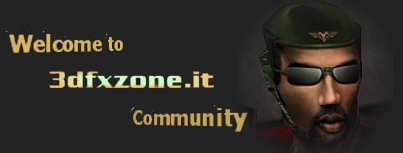Hi. Has anyone had positive results with UT 2003 or UT 2004 on a Voodoo2 card? I gave up a few years ago because I could not find a workaround or fix for important things like the HUD.
However ... I recently tried Daniel Borca's OpenGL "replacement" (http://geocities.com/dborca/opengl/sage.html) on a Voodoo2 and had very good results with some maps. Deck17 is very playable, for example. The FPS is (obviously) higher with two Voodoo2 cards in SLI mode.
All I did was extract opengl32.dll and sage.ini from sage-0.9.2 into C:\UT2004\System. Next, I deleted UT2004.ini to remove the previous settings. After that, I started and exited UT 2004 to recreate a new UT2004.ini file. Finally, I edited UT2004.ini as follows:
1. [Engine.Engine] section
Comment: RenderDevice=D3DDrv.D3DRenderDevice
Uncomment: RenderDevice=OpenGLDrv.OpenGLRenderDevice
2. [WinDrv.WindowsClient] section
Set: FullscreenViewportX=640
Set: FullscreenViewportY=480
Set: TextureDetailInterface=Normal
(set other TextureDetail* settings to Low or VeryLow)
3. [OpenGLDrv.OpenGLRenderDevice]
Set: HighDetailActors=False
Set: SuperHighDetailActors=False
Add: Use16bitTextures=True
Add: Use16bit=True
I have adjusted other settings to see if they make a difference, but the above settings seem to be the most important. I left the settings in sage.ini alone.
The mouse pointer usually does not appear when I run UT 2004, so I press Alt+Enter once to make it appear. I unchecked "Detail Textures" in UT 2004's Settings | Display screen to gain a little speed.
The terrain in some maps such as Antalus looks dull, but hey ~ it's pretty "cool" to be able to play a game like UT 2004 on such an old card.
Long live 3dfx!
However ... I recently tried Daniel Borca's OpenGL "replacement" (http://geocities.com/dborca/opengl/sage.html) on a Voodoo2 and had very good results with some maps. Deck17 is very playable, for example. The FPS is (obviously) higher with two Voodoo2 cards in SLI mode.
All I did was extract opengl32.dll and sage.ini from sage-0.9.2 into C:\UT2004\System. Next, I deleted UT2004.ini to remove the previous settings. After that, I started and exited UT 2004 to recreate a new UT2004.ini file. Finally, I edited UT2004.ini as follows:
1. [Engine.Engine] section
Comment: RenderDevice=D3DDrv.D3DRenderDevice
Uncomment: RenderDevice=OpenGLDrv.OpenGLRenderDevice
2. [WinDrv.WindowsClient] section
Set: FullscreenViewportX=640
Set: FullscreenViewportY=480
Set: TextureDetailInterface=Normal
(set other TextureDetail* settings to Low or VeryLow)
3. [OpenGLDrv.OpenGLRenderDevice]
Set: HighDetailActors=False
Set: SuperHighDetailActors=False
Add: Use16bitTextures=True
Add: Use16bit=True
I have adjusted other settings to see if they make a difference, but the above settings seem to be the most important. I left the settings in sage.ini alone.
The mouse pointer usually does not appear when I run UT 2004, so I press Alt+Enter once to make it appear. I unchecked "Detail Textures" in UT 2004's Settings | Display screen to gain a little speed.
The terrain in some maps such as Antalus looks dull, but hey ~ it's pretty "cool" to be able to play a game like UT 2004 on such an old card.
Long live 3dfx!


 None of this would have been possible without MesaFX, so thanks again for working on it, dborca.
None of this would have been possible without MesaFX, so thanks again for working on it, dborca.